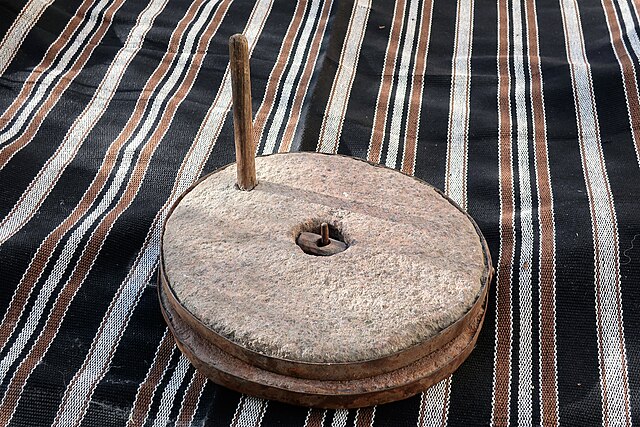Quern-stones are stone tools for hand-grinding a wide variety of materials, especially for various types of grains. They are used in pairs. The lower stationary stone of early examples is called a saddle quern, while the upper mobile stone is called a muller, rubber, or handstone. The upper stone was moved in a back-and-forth motion across the saddle quern. Later querns are known as rotary querns. The central hole of a rotary quern is called the eye, and a dish in the upper surface is known as the hopper. A handle slot contained a handle which enabled the rotary quern to be rotated. They were first used in the Neolithic era to grind cereals into flour.
Disc quern made of basalt stone
The upper stone of a Scottish hand quern from Dalgarven Mill, North Ayrshire
Revolving beehive quern-stones and [lower] a saddlestone on display at Cliffe Castle Museum, in Keighley, West Yorkshire.
A stack of quern-stones for sale in a market in Haikou, Hainan, China. These quern-stones are only about 30 cm wide.
Whernside is a mountain in the Yorkshire Dales in Northern England. It is the highest of the Yorkshire Three Peaks, the other two being Ingleborough and Pen-y-ghent. It is the highest point in the ceremonial county of North Yorkshire and the historic West Riding of Yorkshire with the summit lying on the county boundary with Cumbria. It is the fifteenth most prominent hill in England.
A snow-covered Whernside and RibbleheadViaduct seen from Ribblehead



![Revolving beehive quern-stones and [lower] a saddlestone on display at Cliffe Castle Museum, in Keighley, West Yorkshire.](https://upload.wikimedia.org/wikipedia/commons/thumb/3/36/Cliffecastlemus_016.jpg/640px-Cliffecastlemus_016.jpg)

